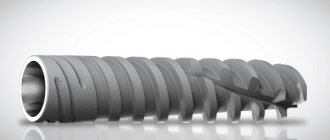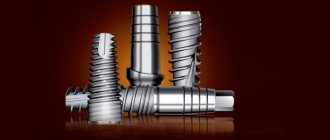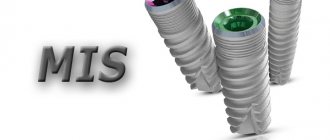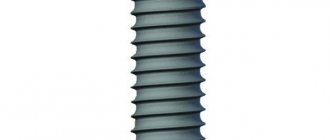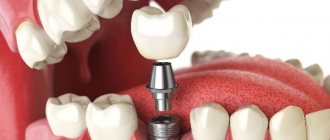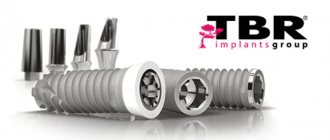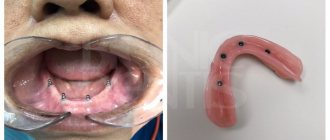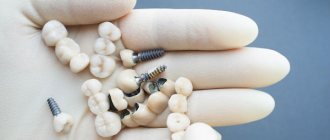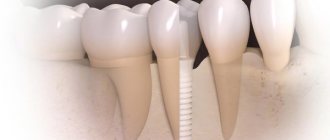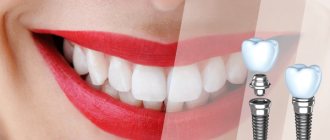Description of features and materials used
All implant models are made of titanium, the surface of the rod is processed using our own patented BCP technology (Biphasic Calcium Phosphate - two-phase calcium phosphate). Design features:
- The rods have a high-precision conical connection with the orthopedic part and a snap mechanism. Due to this, the artificial root is completely hidden under the gum without the risk of soft tissue growing into the cavity.
- The threads have the same pitch along the entire length, which creates good initial stability.
- They have a standard orthopedic platform for any size of abutment.
- The apical part of the structure has a slight taper, which allows installation with minimal trauma.
- The line of implant systems includes very short, but no less strong models that can be installed with thin jaw bone.
Reliable connection of the abutment with the metal root
Anthogyr implants are presented in three lines:
1. The Axiom system was developed based on the results of the latest research and the combination of existing global implantology experience. These are implants with an internal conical connection, one prosthetic platform for all abutment sizes. Axiom are high-strength implants whose line includes the world’s thinnest implant with a diameter of 2.8 mm!
There is also a very short implant - 4.6 mm long! Why is this done? Of course, for the comfort of patients. If there are thin and short reliable implants, there is no need to replant bone tissue and bone substitutes! Axiom PX implants have been developed for installation directly into the socket of an extracted tooth. Again, for the benefit of the patient - we save a lot of time, and the gums around the implant are preserved! The newest line of AXIOM implants was recently released, which allows the use of very short implants where there is not enough bone tissue. This is especially important in the chewing group of teeth after long-term extractions and when installing implants on the upper jaw in the area of the maxillary sinuses.
2. The “classic” Anthofit system is a brand proven by time and experience. All Anthofit implants placed more than 10 years ago are still working successfully!
3. Ossfit system - transgingival implants for removable dentures on bars and telescopes.
Antogir implants are a reliable solution based on scientific developments and the results of long-term clinical studies. A wide range of Antoghir implants allows them to be successfully used in all clinical cases.
The Antozhir implant system is initially focused on a combination of high functionality and aesthetics. A specially designed implant neck is responsible for the aesthetics here - it does not allow bone tissue to form pockets along the implant, thus ensuring the stability of the aesthetic result. Simply put, you will never see the edge of the implant, and the crown installed on such an implant will seem to grow from the gums, completely imitating your own tooth.
A dental implant is a titanium alloy structure that is installed in the patient’s jaw bone to replace the root and serves as a support for fixing an artificial tooth. Therefore, it is especially important to us what implants we use in our practice, since the result of the operation and the long-term wearing of the prosthesis we make directly depend on this. All Antozhir implants are made of titanium, with a surface treated using our own patented HRV technology (biphasic calcium phosphate - biphasik calcium phosphate). Sandblasting with biocompatible HRV microparticles is a highly effective innovative technology that allows you to create an ideal rough surface, which is necessary for reliable stabilization of the implant in the bone, rapid engraftment and long service life. Surface quality is an important factor determining the osseointegration of the implant (fixation of the implant in the bone). The advantage of calcium phosphate apatites is their complete biocompatibility. Used for more than 20 years as a bone replacement material, they have fully proven their osteoinductive potential (increasing bone growth). The implant is firmly connected to the bone and does not cause a rejection reaction.
Advantages and disadvantages of dental implants Antozhir
The advantages of the system include:
- Can be installed using both the classic two-stage method and the instantaneous load method;
- titanium roots are suitable as a support for any type of prosthesis;
- ease of installation;
- moderate traumatic operation;
- Some models can be installed immediately after tooth extraction;
- possibility of implantation in case of bone atrophy;
- rapid osseointegration due to surface porosity;
- The implant can prevent bone thinning.
The disadvantage of the systems is that a microgap is formed at the junction with the abutment, which leads to increased load on the screw. This may cause the abutment to unwind or become deformed.
Product catalog of manufactured implants
Axiom implant system models
The ruler is represented by three conical rods:
- Axiom REG . For classical implantation. Artificial roots of different lengths and diameters allow solving edentulous issues in all areas of the jaw.
- Axiom PX . Used for implantation with immediate load, installed in bone of low density.
- Axiom 2.8. The diameter of the implant is only 2.8 mm. Indicated for reconstruction of anterior teeth where space is limited.
Types of dental implants of the Anthofit system
Implants are distinguished by their versatility and multifunctionality. They are used for single prosthetics with crowns, using cementation, screwing or fastening to a beam structure. Indicated for implantation immediately after tooth extraction. They do not lose stability during inflammation of periodontal tissues.
Models:
- BCP . It has a locking mechanism that is completely immersed in the gum tissue. Used for reconstruction of anterior teeth.
- OI tapered . Stable, conical structure that follows the anatomical structure of the natural root. Has an octagonal retainer with a depth of 1.5 mm.
- OI straight . Cylindrical implant with hexagonal lock.
- HE straight . It has similar properties to OI straight; it is a cylindrical rod with a hexagon, the height of which does not exceed 0.5 mm.
Ossfit dental implants for dental prosthetics
They are used to restore distant roots, since the design provides for a gap between the gum and the crown, which can affect the aesthetics. They do not require extensive surgical intervention; they are installed using a one-stage method through a small puncture in the gum.
Types of Antogir implants
Axiom
The line consists of particularly durable canonical designs, among which there are miniature versions with a length of 4.6 mm and a diameter of 2.8 mm. They are suitable for restoring the dentition with a lack of bone tissue, including its deficiency in the area of the maxillary sinuses in the upper jaw.
Ossfit
“Antozhir” implants of this series are installed using a minimally invasive method, so the operation and healing are quick. The product is suitable for one-stage implantation. Placed in areas where aesthetics is not a primary concern.
Anthofit
The proven classic is well fixed, takes root quickly and does not injure tissue. The designs of this line are highly durable due to the treatment of the pins with phosphorus-calcium apatite.
- Anthofit HE straight is a cylindrical pin with an external hexagon. Used for classical restoration.
- Anthofit OI tapered is a conical implant with an octagon on the outside, placed in difficult cases. Gives a super strong hold because it is shaped like a natural tooth root.
- Anthofit OI straight is a cylindrical design with an octagon inside. Thanks to its special carving, it is famous for its good osseointegration. Used for implantation of varying complexity.
Initial consultation
- Oral examination
- Making a treatment plan
- Drawing up a treatment estimate
For free
How to install and stages of prosthetics
Anthogyr implant systems are suitable for the reconstruction of any number of teeth, up to complete edentia. Abutments and dentures are fixed on them in one of the following ways:
- cementing;
- screw-in lock;
- ball lock;
- beam structure.
Stages of classical implantation:
- Initial examination, identification of indications.
- Sanitation of the oral cavity.
- X-ray examination.
- Taking tests to identify contraindications.
- If there is insufficient bone volume, a sinus lift or bone augmentation is performed.
- An operation to implant the root under local anesthesia with further installation of a gum former.
- After 2-4 months, installation of the abutment.
- After 2-3 weeks, prosthetics of the implanted artificial root is performed.
Which implants are better: comparison of some popular types
German XIVE Friadent systems (Xive)
Peculiarities:
- can be installed on bone of any volume, even too thin and porous;
- Friadent surface treatment accelerates osseointegration;
- According to research, the survival rate is 99.6%.
The price for XIVE implantation on a turnkey basis with a metal-ceramic crown is from 50 thousand rubles, with a zirconium crown – from 60 thousand rubles.
Korean implants DIO (Dio)
Peculiarities:
- surface treatment using German BioTite-H technology accelerates engraftment;
- There are narrow models for limited spaces in the jaw;
- The internal Tors connection eliminates the possibility of the abutment coming loose.
The price of a turnkey installation with a metal-ceramic crown is from 30 thousand rubles, with a zirconium crown – from 45 thousand rubles.
Bicon implants from the USA
Peculiarities:
- the ability to perform surgery for reduced alveolar processes, bone atrophy and periodontal diseases;
- hermetic connection eliminates the risk of infection of the operated area;
- low invasiveness of the operation, the titanium root is installed through a small puncture.
The price of a turnkey Bicon installation with a metal-ceramic crown is from 65 thousand rubles, with a zirconium crown – from 80 thousand rubles.
Swiss Straumann systems
Peculiarities:
- the cone-shaped shape of the implant repeats the structure of the alveolus of the root;
- lifetime warranty;
- surface treatment using SLA technology ensures high hydrophilicity and rapid osseointegration;
- possibility of full load within a month after implantation.
The price of a turnkey Strauman installation with a metal-ceramic crown is from 77 thousand rubles, with a zirconium crown - from 90 thousand rubles.
Implant systems
Implants Nobel Biocare
Peculiarities:
- the ability to carry out one-stage implantation with immediate loading;
- large selection of sizes and 3 types of connection: external, conical and three-channel;
- surface treatment using patented TiUnite technology, which can activate fibrin, absorb blood proteins and improve platelet activity.
The price for Nobel Biocare “turnkey” implantation with a metal-ceramic crown is from 65 thousand rubles, with a zirconium crown – from 80 thousand rubles.
Astra Tech implants from Sweden
Peculiarities:
- OsseoSpeed coating activates tissue regeneration;
- a rough surface (after treatment with fluoride) improves bonding with bone tissue;
- The unique Microthread thread ensures a secure fit with the prosthesis.
The price for a turnkey Astra installation with a metal-ceramic crown is from 62 thousand rubles, with a zirconium crown – from 80 thousand rubles.
Israeli MIS implants
Peculiarities:
- conical shape and spiral channels allow you to install the rod into bone of any volume;
- SLA surface;
- strong connection with the abutment eliminates the risk of unwinding;
- official guarantee 5 years.
The price for a turnkey MIS installation with a metal-ceramic crown is from 40 thousand rubles, with a zirconium crown – from 50 thousand rubles.
Alpha Bio implants from Israel
Features of Alpha Bio:
- high primary stability;
- tight gingival fit;
- the ability to install an implant into rarefied bone.
The price of a turnkey installation with a metal-ceramic crown is from 39 thousand rubles, with a zirconium crown – from 53 thousand rubles.
Osstem dental implants from South Korea
Features of Osstem:
- Each titanium rod is sandblasted with aluminum oxide, acid etched and enriched with calcium;
- the design has a self-tapping thread with a spiral edge, which allows maneuvering during installation;
- availability of monolithic and collapsible rods.
The price of turnkey implantation with a metal-ceramic crown is from 43 thousand rubles, with a zirconium crown – from 65 thousand rubles.
Israeli and Korean implants
Kinds
The Antozhir company's products are represented by several series, each of which has different models designed to solve various problems.
The full catalog and rating of manufactured designs can be found on the company’s official website.
Axiom system
This system is represented by conical implants. They have increased strength and can be installed in bone of any size.
The Axiom series is represented by several models :
- REG – are easy to install due to their unique thread and conical shape. This model includes structures of different lengths and diameters, which can be installed both in the anterior and lateral sections of the dentition.
- PX – used for immediate loading of the artificial root. The main purpose is installation in low-density bone tissue.
- 8 – at the moment they are the thinnest implants, the diameter of which does not exceed 2.8 mm. Designed to replace defects in the anterior part of the dentition in conditions of limited space.
The cost of Axiom models starts from 10 thousand rubles .
Anthofit system
This type of implant is characterized by wide functionality and versatility. They can be used to install single crowns as well as cemented, screw-in or bar-based dentures.
The Anthofit system is mainly used for immediate fixation of the product immediately after tooth extraction. They have good survival rate and do not lose their stability in case of pathologies of periodontal tissue.
The series is represented by the following models :
- BCP - used to restore front teeth, as they have a unique locking mechanism and neck of the product. Thanks to them, the implant is completely immersed in the gum tissue.
- OI tapered is a conical product equipped with an octagonal retainer, the depth of which is 1.5 mm. The stability of the structure is given by the anatomical shape, which completely replicates the natural root.
- OI straight are cylindrical implants that also have a hexagon as a locking mechanism.
- HE straight , as well as the previous version, are cylindrical implants with a hexagon. But in this case, it has a height of no more than 0.5 mm.
The cost of the listed models starts from 6 thousand rubles .
Ossfit system
The Ossfit system refers to transgingival implants and is represented by only one model, but in different sizes . It is intended to compensate for dental defects in areas where aesthetics are not important.
The special design implies a gap between the crown and the implant, which affects the appearance: the crown may have an indentation from the gum line.
Ossfit is used for one-step installation and requires minimal surgical intervention. Most often used for prosthetics on telescopic or beam locks.
The cost of the Ossfit system is on average 6 thousand rubles .
